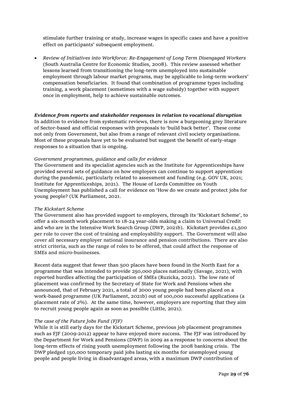
Page 29 of 76
stimulate further training or study, increase wages in specific cases and have a positive
effect on participants' subsequent employment.
• Review of Initiatives into Workforce: Re-Engagement of Long Term Disengaged Workers
(South Australia Centre for Economic Studies, 2008). This review assessed whether
lessons learned from transitioning the long-term unemployed into sustainable
employment through labour market programs, may be applicable to long-term workers'
compensation beneficiaries. It found that combination of programme types including
training, a work placement (sometimes with a wage subsidy) together with support
once in employment, help to achieve sustainable outcomes.
Evidence from reports and stakeholder responses in relation to vocational disruption
In addition to evidence from systematic reviews, there is now a burgeoning grey literature
of Sector-based and official responses with proposals to 'build back better'. These come
not only from Government, but also from a range of relevant civil society organisations.
Most of these proposals have yet to be evaluated but suggest the benefit of early-stage
responses to a situation that is ongoing.
Government programmes, guidance and calls for evidence
The Government and its specialist agencies such as the Institute for Apprenticeships have
provided several sets of guidance on how employers can continue to support apprentices
during the pandemic, particularly related to assessment and funding (e.g. GOV UK, 2021;
Institute for Apprenticeships, 2021). The House of Lords Committee on Youth
Unemployment has published a call for evidence on 'How do we create and protect jobs for
young people? (UK Parliament, 2021.
The Kickstart Scheme
The Government also has provided support to employers, through its 'Kickstart Scheme', to
offer a six-month work placement to 18-24 year-olds making a claim to Universal Credit
and who are in the Intensive Work Search Group (DWP, 2021b). Kickstart provides £1,500
per role to cover the cost of training and employability support. The Government will also
cover all necessary employer national insurance and pension contributions. There are also
strict criteria, such as the range of roles to be offered, that could affect the response of
SMEs and micro-businesses.
Recent data suggest that fewer than 500 places have been found in the North East for a
programme that was intended to provide 250,000 places nationally (Savage, 2021), with
reported hurdles affecting the participation of SMEs (Ruzicka, 2021). The low rate of
placement was confirmed by the Secretary of State for Work and Pensions when she
announced, that of February 2021, a total of 2000 young people had been placed on a
work-based programme (UK Parliament, 2021b) out of 100,000 successful applications (a
placement rate of 2%). At the same time, however, employers are reporting that they aim
to recruit young people again as soon as possible (Little, 2021).
The case of the Future Jobs Fund (FJF)
While it is still early days for the Kickstart Scheme, previous job placement programmes
such as FJF (2009-2012) appear to have enjoyed more success. The FJF was introduced by
the Department for Work and Pensions (DWP) in 2009 as a response to concerns about the
long-term effects of rising youth unemployment following the 2008 banking crisis. The
DWP pledged 150,000 temporary paid jobs lasting six months for unemployed young
people and people living in disadvantaged areas, with a maximum DWP contribution of